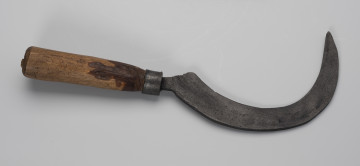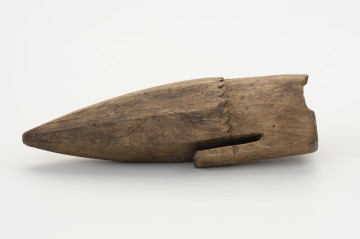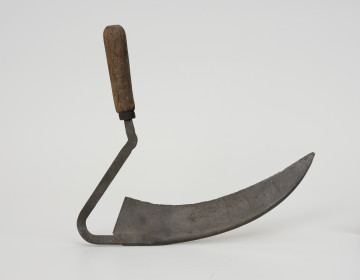
Sickle
1901 — 1945
National Museum in Szczecin
Part of the collection: Middle Ages
An iron sickle with a mandrel for setting the handle found during excavations at the early medieval settlement in Golczewo, the Kamień district, in the cultural layer from the 10th to 12th century. Sickles are harvesting tools used to cut grass and grain. Their history is very long, dating back to the time of the oldest farmers in the Neolithic period. The raw material from which they were made has changed over the millennia, from flint inlays in wooden frames through bronze sickles to the iron sickles we know today. In times of armed conflict, iron sickles mounted on long spars became dangerous weapons. In times of peace, they fulfilled their primary function but also had a symbolic meaning. The sickle placed in the grave is associated with anti-vampiric practices, while the sickle thrown into the lake was supposed to protect people from evil forces. The belief in the protective power of iron sickles survived in some European regions until modern times. In Belarus, sickles were placed on cowshed doors on Midsummer Eve to cripple witches trying to cross the threshold of the building. An early medieval sickle from Golczewo was forged from a single piece of iron. It has a smooth blade with a broken tip and a long shank for setting a wooden handle. It is a medium-sized tool, the most widespread in the early Middle Ages.
Sławomir Słowiński
Author / creator
Dimensions
cały obiekt: height: 22.2 cm, width: 3 cm
Object type
sickle, agricultural equipment
Technique
grinding, bending, forging
Material
iron
Origin / acquisition method
legal transfer
Creation time / dating
Creation / finding place
Owner
Muzeum Narodowe w Szczecinie
Identification number
Location / status

1901 — 1945
National Museum in Szczecin

1925 — 1935
National Museum in Szczecin

1880 — 1910
National Museum in Szczecin
DISCOVER this TOPIC
Castle Museum in Łańcut
DISCOVER this PATH
Educational path